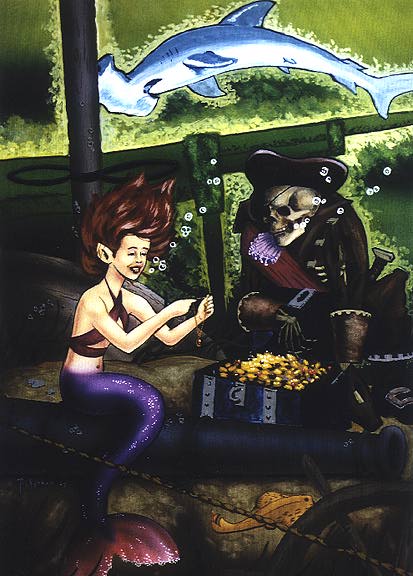

Editor's Note: While foraging around the web one day looking for parts for my Iwata, I stumbled across Jay's website. Since I have a profound respect for anyone who can draw and airbrush, I spent some time on his site...and his work is incredible, even if it's not ships :-) Although these articles are written for aspiring airbrush artists, modelers can learn alot from folks like Jay. I'd like to thank Jay for allowing us to use his articles to help out modelers who are intimidated by airbrushes, and to those who are just getting started. Thanks Jay!
SELECTING YOUR FIRST AIRBRUSH
There are basically two tipes of airbrush. Single Action and Double Action. Both terms refer to the trigger action. With a double action airbrush, the trigger controls the air flow and the paint flow. With a single action, the trigger only controls the air flow. There is a seperate control for the paint.
I highly recommend that the beginner buy a Double Action airbrush. Single Action models are too primitive and lack fine control. The beginner will just get frustrated with a Single Action.
I also recommend that the beginner not buy one of the top of the line models. The high end models can be more trouble than they are worth, especially to someone who is just learning the basics. Also avoid any airbrushes that have silly gimmicks. Maintanence free models, swivelling barrel models, etc. An inexpensive, basic, double action is what the beginner needs. The Badger 150, Paasche VL, and Vega 2000 are good examples of what I'm talking about.
As I've already said, the trigger controls the air and the paint. Push down on the trigger, and you open the air valve. Pull back on the trigger, and you introduce paint into the air stream. The more you pull back, the more paint is added to the air stream.
Never pull back on the trigger without pressing down on it. That would allow paint into the airbrush before the air stream was on, which would just make a mess. Always turn the air on first, then the paint, and always shut the paint off before the air. It's best to just turn the air on and leave it on. In other words, keep your finger pressed down on the trigger, as you work. Just turn the paint on and off by rocking your finger back and forth.
There is a relationship between how far you pull back on the trigger, and how far away from the surface you should hold the airbrush. The farther back you pull, the farther back the airbrush should be. For starters, hold the airbrush about two inches away from the surface, and pull the trigger back about one quarter of its travel length. Then experiment with different ratios to see the different results.
There is also a relationship between how thick you mix the paint and how high the pressure should be. The thicker the paint, the more pressure you'll need to spray it. If the pressure is too high, or the paint too thin, you'll get a lot of puddling and running. Fix this by turning down the regulator, or stop thinning down the paint so much. If the pressure is too low, or the paint too thick, instead of getting a nice soft spray, you'll get a grainy, stipply type spray, and the airbrush will clog a lot. Fix this by turning up the air pressure, or thinning down the paint a bit more.
Usually, ready to spray airbrush paint works well around 30 PSI. Artist acrylics and enamels work best at a little higher pressure. Watercolors and inks work best at about 20 PSI. These numbers are just guidelines. You'll have to experiment on your own to come up with your own ideal ratio.
One of the best ways to learn freehand airbrushing is to try writing with it. If you can write with an airbrush, your ability to paint with it will only be limited by your drawing skills. Start off trying to write your name, and gradually work your way up to sentences. When you can write with an airbrush as easilly as you can with a pen, then try drawing with it. Start off with just black paint, working in outline, like you would with pen and ink. Then try coloring in your black and white drawings. Finally, trying working with just color, no black outlining.
Remember to clean your airbrush thoroughly after each painting session.
That's all for now.
James Trefethen
